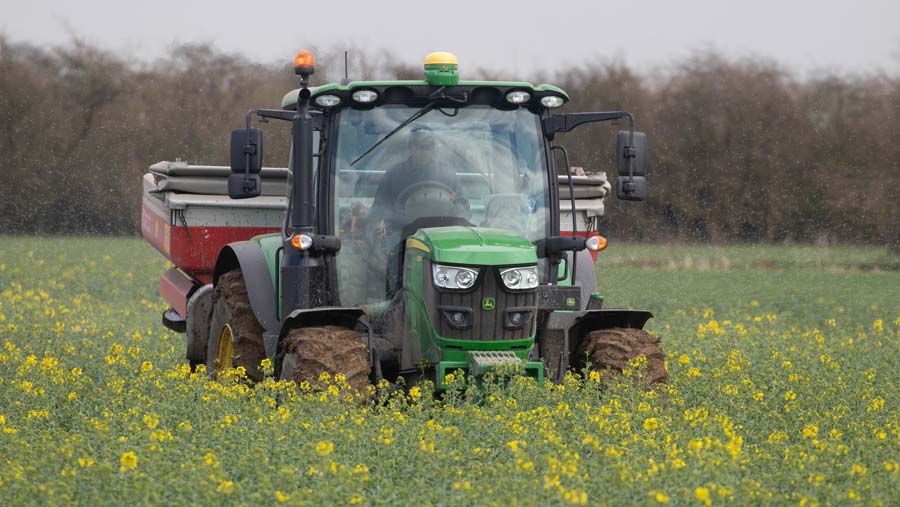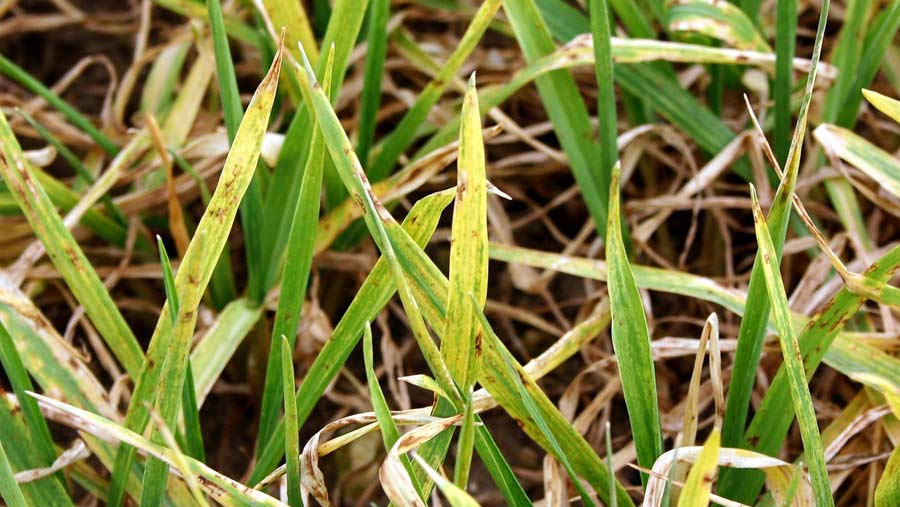Crop Watch: Fieldwork backlog after monsoon March
 Applying nitrogen to OSR © Tim Scrivener
Applying nitrogen to OSR © Tim Scrivener A more settled spell of weather brings hope of catching up on the massive backlog of fieldwork that has built up during monsoon March.
There is fertiliser to apply, overdue herbicide applications and T0s due for winter wheat and barley along with the spring drilling that has been on hold.
See also: Carbon audit highlights priorities for net-zero success
Oilseed rape crops that have survived are now approaching flowering and thoughts are turning to flowering fungicides.
North: Patrick Stephenson
AICC (Yorkshire)
As much as the rain was required to top up water supplies, it does nothing to improve the mood of agronomists.
Having had a superb February and in full agronomic control, we now are standing on a cliff edge watching the potential workload building up.
The early drilled winter wheat crops are now approaching growth stage 30, and some are excessively big. Managing these is going to be a battle all season.
My preferred method is to split a growth regulator programme between GS30 and GS32.
As a rule of thumb, if a sulfonylurea grassweed herbicide has been used, there is enough crop check for me to regard this as first part of the growth regulator programme.
The second application would then coincide with T1 fungicides timing.
The cool weather in March has stopped yellow rust in its tracks, but I know a return to warmer conditions will see the yellow peril burst into life.
T0 decisions that were made may now merge into T1, with most T1 sprays based around mefentrifluconazole.
In some specific circumstances a prothioconazole-based mixture will be the order of the day.
The main nitrogen timing will be after the middle of this month.
Despite the recent fall in nitrogen prices, most growers purchased product at the height of the market and, therefore, rates will be cut back by about 20kg/ha.
Winter barley
Winter barley crops are at GS 30 and stem elongation has started, the final nitrogen pass and the first fungicide are now due.
With generic versions of prothioconazole one of the few products not to have seen a huge price increase, I will be attempting some alchemy in the barley programmes with a range of mixtures.
Net blotch and brown rust are the main diseases, with the hybrids exhibiting a ginger hue.
A robust growth regulator programme is also planned, with a chlormequat + trinexapac mixture being my favoured choice.
The autumn herbicide programmes have worked very well, and my usual dilemma of timing wild oat control is eased.
The cold snaps have flushed wild oats up early so the first spray will include a graminicide where required.
The early drilled spring barleys are now through and will have the rest of their nitrogen applied as soon as conditions allow.
Where pigeons have left oilseed rape crops alone, they are limping into flower. I will recommend a broad-spectrum fungicide at full flowering.
In my opinion it will at least cover the cost and in most years produce a profitable yield improvement.
Unfortunately, the addition of insecticides I find much harder to justify and these will be added only in very specific circumstances. Sadly, some crops are still being written off.
Winter beans did not like the winter cold snaps and the subsequent rain and winds have left some very battered and bruised.
My instinct is that some of the damage is fusarium foot rots, but we will see when I get some samples analysed.
After many years of trying to control bruchid beetle, pea and bean weevil, I have declared a peace treaty and will no longer risk killing bees and let nature take its course.
In terms of agronomic decisions this leaves chocolate spot and rust control, which will be monitored and targeted after flowering has started.
South: Oliver Bennetts
Zantra (Kent)
As we move into April I’m keeping my fingers crossed for a change from a rainy and windy March to a drier April.
During the month we’ve barely turned a wheel, with only a couple of decent days.
Now farmers are looking at a build-up of work with T0s, herbicide and fertiliser applications and some drilling/planting all needing to be done.
At least as we head towards the end of the month, temperatures are slowly increasing (although we are still getting the odd frost) and crops are responding to the nitrogen that was applied at the end of February as it is now reaching the root zone.
On another positive note, wheat crops are currently looking clean other than septoria and so far, I have only seen a few patches of rust on expected varieties.
While these are very few and far between, because the variety mix in the area is dominated by Group 1 millers, it is important to use early season treatments based on a good, rust-active azole and a multisite to help with septoria.
In addition, as milling wheats demand higher rates of nitrogen to meet protein specifications, this means a robust plant growth regulator is also to be included.
Flowering
With oilseed rape fast approaching flowering in the area, and green buds visible in most crops, we’re not far away from seeing the classic yellow fields.
Fortunately, cabbage stem flea beetle damage locally is at a minimum.
Most of the crop damage is coming from pigeons, possibly down to fewer crops in the area, leading to bigger groups landing and stripping leaves.
As with cereals, OSR fungicides and plant growth regulators are yet to go on, just waiting for a break in the weather.
With such a valuable crop, we are looking to protect it as best we can.
Some farms took the opportunity of a dry February to get spring barley drilled, into some excellent seed-beds. This is now emerged with one to two true leaves.
However, since those crops were drilled and sprayed the weather has prevented much else happening in terms of establishing other spring crops.
Potato planting is just around the corner, with some cultivations done, but seed-bed fertiliser and de-stoning will be happening very soon.
Plans for residual herbicides are being talked over, with pendimethalin, prosulfocarb and aclonifen included in the discussion.
West: Gavin Burrough
Pearce Seeds (Dorset, Hampshire and Wiltshire)
Since my last column, we have had 139mm of rain in March and very little fieldwork has happened, with the occasional day spreading fertiliser and even fewer days spraying.
Thankfully, at the time of writing, the forecast looks more settled and, hopefully, fieldwork can soon commence again.
The spring barley that was drilled in February is up at two-leaf stage and is generally looking well.
With all the rain we have had since it has been drilled, we will soon have a flush of weeds that may need to be taken out sooner rather than later.
I normally try and tie a broad-leaved weed herbicide in with a T1 fungicide on spring barley, but I would have thought that an earlier pass of herbicide would be beneficial to avoid weeds being too large this spring.
Some weeds, especially charlock, can be a problem if they get going too early, so an application of mecoprop-P soon knocks them down if they are a problem.
There are plenty of spring cereals left to drill along with peas when ground conditions dry up enough.
Where possible, spring cereal seed rates will be increased to compensate with being drilled later than planned, generally around the 375-400 seeds/sq m mark.
Peas
The peas will have a pre-emergence herbicide, either containing pendimethalin and imazamox or pendimethalin mixed with clomazone, if cleavers are more of an issue.
OSR that survived the winter and hasn’t been affected by flea beetle larvae is growing away well and approaching flower bud stage, it looks like it will begin to flower in the next week or so.
Hopefully, pollen beetle wont be an issue as temperatures over the next few days do not look to be high enough for them.
Winter barley is either growing away well and rapidly approaching T1 stage or struggling due to wet feet.
Unfortunately, wild oat and/or ryegrass control has not yet been applied due to the poor weather/ground conditions, so there will soon be a lot to apply to fast-growing crops.
Care will be needed with tank mixes and grassweed/broad-leaved weed herbicide intervals.
It is a similar story with wheat, and there are several fields that haven’t had grass and broad-leaved weeds tidied up as early as we would like.
East: Marcus Mann
Frontier (Essex)

Mosaic virus in barley © Blackthorn Arable
In response to increasing day length and temperature, as well as a first application of nitrogen, cereal crops are quickly moving through their growth stages.
Given the unsettled weather throughout March, there has been very little opportunity for fieldwork, resulting in an ever-increasing backlog of jobs.
Winter wheats are now stem extending and will require large doses of nitrogen to support this growth, alongside disease management and fungicide applications at T0.
Disease pressure in general remains relatively low. The early yellow rust pressure is down on that seen in previous years.
However, it is crucial to maintain a zero-tolerance approach to this disease, as chasing epidemics later in the season is never as effective and will cost more.
The mild winter and above average rainfall throughout March have resulted in far more septoria being present in the base of many crops.
In forward crops, inoculum will undoubtedly already have been spread on to the high leaf layers.
It is essential that T1 fungicide recommendation are appropriate to manage the risk presented by this disease.
Growth regulators
With nitrogen being well utilised it will be important to include plant growth regulators with the T0 applications.
In earlier drilled cleaner varieties such as Dawsum and Extase that may not require disease control, split PGR applications may still be important.
Winter barley is quickly reaching GS31 and will soon be at T1 timing. This is the most important timing as leaf 2 and 3 provide the most light interception.
Rhynchosporium levels are high in certain varieties and robust rates will be required, particularly if a T0 has not been applied.
This year there appears to be an increase in mosaic virus and concerningly in varieties claiming genetic resistance.
For suspect yellow areas it is worth confirming by sending a sample for confirmatory testing.

